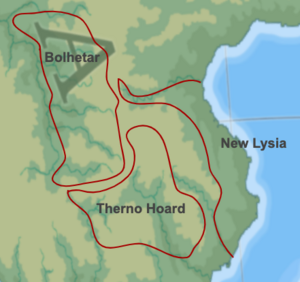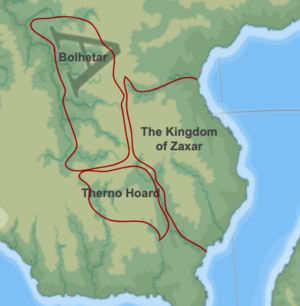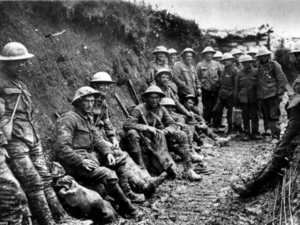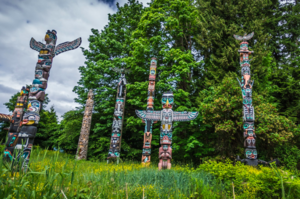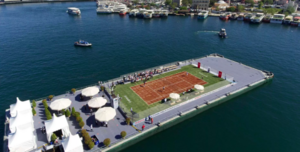Zaxar: Difference between revisions
m (→Politics) |
|||
| Line 183: | Line 183: | ||
After his father's retirement, William I Zaxar was crowned Emperor of Greater Zaxar on October 2, 2020. William has spent the first year of his reign attempting to rapidly modernize Zaxar as well as forging a new national identity which all Zaxar citizens can unify behind. This brings us to Zaxar today, which has fallen behind its neighbors in technology, has population shortages, lacks infrastructure, and whose economy is still in shambles due to 73 years of total war of unification. However, the light is visible at the end of the tunnel for Zaxar as through William’s strong leadership and the unified power of the people, Zaxar is set on a path to flourish. | After his father's retirement, William I Zaxar was crowned Emperor of Greater Zaxar on October 2, 2020. William has spent the first year of his reign attempting to rapidly modernize Zaxar as well as forging a new national identity which all Zaxar citizens can unify behind. This brings us to Zaxar today, which has fallen behind its neighbors in technology, has population shortages, lacks infrastructure, and whose economy is still in shambles due to 73 years of total war of unification. However, the light is visible at the end of the tunnel for Zaxar as through William’s strong leadership and the unified power of the people, Zaxar is set on a path to flourish. | ||
==Politics== | ==Government and Politics== | ||
(Government. Separation of powers. Who rules, how, and for how long? What levels of government exist? How about the local level? Who makes the laws? Who deals out your justice? Which government services exist? What is the name of your police? How are the armed forces organized? Foreign affairs, alliances, membership of international organizations.) | (Government. Separation of powers. Who rules, how, and for how long? What levels of government exist? How about the local level? Who makes the laws? Who deals out your justice? Which government services exist? What is the name of your police? How are the armed forces organized? Foreign affairs, alliances, membership of international organizations.) | ||
Revision as of 13:47, 4 December 2021
Zaxar | |
|---|---|
| Motto: "From the Blizzard, a Blank Canvas" | |
| Anthem: "March of the Greens" | |
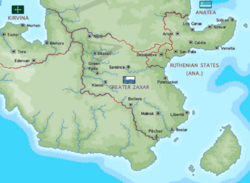 Map of Greater Zaxar | |
| Capital and largest city | Sandrica |
| Official languages | Wampanoag, Lysian |
| Ethnic groups | Zaxar (50%), Wampanoag (30%), Lysian (10%), Other Native Aurelian (8%), Other (2%) |
| Demonym(s) | Zaxar |
| Government | Absolute monarchy |
• Emperor | William Zaxar |
• Empress | N/A |
• Crown Heir | Benjamin Zaxar (brother) |
| Legislature | Zaxar Senate |
| Establishment | |
• Wampanoag Empire | 1000 CE |
• New Lysia | 1523 CE |
• Kingdom of Zaxar | 1803 CE |
• Empire of Greater Zaxar | 2000 CE |
| Area | |
• | 778,000 km2 (300,000 sq mi) |
| Population | |
• Estimate | 10,000,000 |
• 2021 census | 10,000,000 |
• Density | 12.85/km2 (33.3/sq mi) |
| GDP (PPP) | estimate |
• Per capita | 20,000 Ƶ (200,000,000,000 Ƶ) |
| GDP (nominal) | estimate |
• Total | 50,000,000,000 Ƶ |
• Per capita | 5,000 Ƶ |
| Gini | 37.6 medium |
| HDI | 0.8496 very high |
| Currency | Zaxar Mark (Ƶ) (ZAX) |
| Date format | dd/mm/yyyy |
| Driving side | right |
| Calling code | +617 |
| Internet TLD | .zax |
This article is incomplete because it is pending further input from participants, or it is a work-in-progress by one author. Please comment on this article's talk page to share your input, comments and questions. Note: To contribute to this article, you may need to seek help from the author(s) of this page. |
The Empire of Greater Zaxar, often referred to internationally and by locals as Zaxar, is a sovereign nation located in the southeastern Aurelia on Eurth. Zaxar's capital city is Sandrica which is located on the banks of the Glenne River and boasts a population of just over four million inhabitants. Zaxar is bordered to the west by Kirvina, to the northeast by Anatea, and to the south by the Adisi Ocean. The Zaxar city of Bostar is recognized as the southernmost city in the Wurld. The Empire has a population of 11 million, which is fairly urbanized, with just over half of the population concentrated in the nine largest cities. The population is largely concentrated in several distinct regions including the Sarthus River Basin, the southern coastline, and the foothills surrounding Niyol. The total area of the Empire is 778,000 square kilometres (300,000 sq mi). The official languages are Wampanoag, which is the most commonly used language, and Lysian, which is mainly spoken along the northeastern coast and in the city of Pawtucket. There are several other minority languages and dialects, mainly among the non-Wampanoag native Aurelians of southwestern Zaxar. The Empire has no official national religion, although Totemism is practiced by the vast majority of the country, including the royal family.
The Empire of Greater Zaxar is a dynastic absolute monarchy under the Zaxar Dynasty, although Zaxar does have an elected senate which has no real power and serves instead as a representitive advisory council to the Emporer. The current ruler is Emporer William I Zaxar, who has ruled Zaxar since his father's retirment in the year 2000. The financial capital of Zaxar is the historical port city of Bostar, although it appears as if it will soon be overtaken by the rapidly growing mining city of Niyol. Zaxar has been around in some form for hundereds of years although it only recently joind the Wurld stage after the end of its unification war in 2000 CE. Today Zaxar is an emerging power on the Wurld stage and it is currently experiencing rapid economic and social growth as it recovers from the end of its bloody unification war.
The Greater Zaxar economy is considered to be very weak at the moment although it is currently experiencing rapid expansion which has caught the eyes of several foreign investors. The economy is largely supported by the agriculture and aquaculture industries with significant contributions from the newly emerging lithium mining sector which is often considered by experts to be the single most promising opportunity for the growing Zaxar economy. Zaxar maintains positive diplomatic relations with most of its Aurelian neighbors while also having embassies and economic ties established with the Europan power of Tagmatium. Zaxar is currently working to expand its diplomatic corps and the Emperor has expressed his interest in creating closer economic and political ties with his Aurelian neighbors.
Etymology
The name Zaxar comes directly from the dynasty of the first ruler of the nation, William Zaxar. The name Greater Zaxar came about in order to differentiate the new united kingdom’s name from the former Kingdom of Zaxar which was William Zaxar’s birthplace.
The standard way to refer to a citizen of Greater Zaxar is as Zaxarian or as a Zaxar.
Geography
(Landscape. Climate. Where exactly is your nation compared to others on the global map? Describe the landscape, plants and animals. Which mountains and rivers are important to include? Describe are the climate and seasons? How does geography determine where people live? Are there areas separated from one another? How about cities? This will greatly help you with the next part of history.)
History
Before the idea of the nation of Zaxar had even been conceived, the vast lands which the nation encompasses today were in chaos. Politically fragmented for much of its history, the land was ruled by hostile native clans and kingdoms who constantly sought to undermine and destroy each other through bloody warfare, genocide, and backstabbing. Little, in detail, is known about this period before 200 CE due to the frequent book burnings brought about through the warfare and much of what we do know comes from myths and legends passed down through stories and songs and the accuracy of these oral “histories” is largely considered unreliable by scholars. The holy grail of Zaxar’s more modern history is La Histori Del Sur which is a well sourced and thorough history of the Kingdom of Zaxar from 1536-1841 written by the famed Zaxar historian Codin Maxillo and published in 1843. This is where most of our knowledge of Zaxar’s founding and early history comes from.
First Nations (100 BCE - 1000 CE)
The land which is today known as Zaxar is somewhat isolated, with it being the southernmost country on Eurth and having a long history without Europan involvement. The first known countries to be established in Zaxar were the Latazeca and Opatomal Clans located along the eastern bank of the Sarthus River (known as the Sagraphas in Kirvina). These clans would go on to expand to eventually settle most of the river basin before a series of earthquakes, floods, and fires caused the clans to dissolve into hundreds of smaller clans. The most notable of these clans were the Varus, the Guine, the Tolchar, and the Mahran. Around this time is also when the most important of the clans formed just south of the Sarthus River in the Glenne River Basin, the Wampanoag. After about 100 years, these 5 clans had managed to unite and consolidate most of the smaller clans, which led to the division of land shown below.
It was also at about this time that a four way conflict started between the Sarthus River Clans, presumably over the division of Guine lands, as they were the weakest of the four. As the Guine War dragged on, it opened up an opportunity for the Wampanoag Clan to invade their normally stronger western neighbors. And invade they did, after just two years the elite Wampanoag Wolf Warriors had crushed the forces of the other clans and expelled their peoples from the Sarthus Basin entirely. This total victory left the Wampanoag as the sole superpower of the Greater Zaxar region and inspired their leaders to continue the conquest for generations to come.
First Empire (1000-1523)
Throughout the eleventh century, Wampanoag continued to expand across the region. Most of their expansion and annexation was done entirely without violence as their Wolf Warriors were so feared by their much smaller neighbors who had heard rumors of a brutal genocide committed by Wampanoag against the Mahran peoples. While these rumors are very likely untrue as there is no historical evidence of it, it is thought that the rumors were propagated by Wampanoag itself in order to intimidate its enemies.
By the year 1100 CE, the Empire had reached its greatest extent in territory, with it stretching nearly to Zaxar’s modern borders, controlling nearly all the major population centers in Zaxar of the time. The culture and traditions of Wampanoag also largely developed during this time, with famous cultural sites such as the Sandrica Bridge and Bostar Lighthouse being built. Facing no real external threats, Wampanoag had time to develop its economy as well, with the first fisheries and oyster farms being developed. Many of which are still in use today, as the aquaculture practices of these early farmers have been ingrained into the greater Wampanoag culture. This time period is often considered by historians to be the first Zaxar Empire, despite the people of this time having never even met an Europan yet. However, that was all about to change and bring with it devastating consequences for the Wampanoag people.
Colonization and Conquest (1523-1800)
The Wampanoag rulers had long known about the Europan colonists of neighboring Kirvina and had often traded with them through third-party clans and tribes, unknowingly building up the natural immunity of the nation against Europan diseases. There was still, however, a large outbreak of smallpox when the first Europan ships arrived at Wampanoag shores. These six ships carried about 3,000 Lysian slave soldiers from Europa, where they had mutinied and took control of the fleet that was meant to bring them to war. Their aim had been to find a new land where they could start an independent colony, and the land of Zaxar had the perfect climate for Europan settlement. After making landfall, these soldiers immediately began to conquer the natives with their superior firearms and armor. Before long, they had carved out a small kingdom for themselves along the coast and settled in, marrying the local Wampanoag peoples and adopting much of their culture. This swift and humiliating defeat immediately caused the near total collapse of the Wampanoag Empire, with it fragmenting into many small states. It only took about ten years after that for three powers to come out as dominant in the region: New Lysia ruled by the Drogts, Bolhetar in the west, and the Therno Hoard in the south. New Lysia was, at first, the most populated of the new states and was the richest through trade with countries across the ocean. Bolhetar was an agricultural society and pioneered the use of irrigation in the Sarthus River Basin as well as opening up trade with nations in the west by shipping their excess grain down the Sarthus River; this trade with nations such as Rhodellia and Kirvina gave Bolhetar access to foreign investment and aid that would become crucial to its future. The Therno Hoard was a pastoral society where life revolved entirely around the raising of sheep, goats, and horses. This turned Therno into the most feared of the three nations, as their cavalry was thought to be the best in Aurelia.
Direct wars between the three powers were infrequent and mostly limited to proxy wars and local militias along border regions. This balance of power would not last forever, though, and would soon lead to the war that would shape Zaxar for generations to come.
Kingdom (1800-1926)
In New Lysia, contrary to one would expect, there was very little ethnic and racial tension due in part to the accepting and friendly nature of the Wampanoag people although mostly because when the Lysian slave fleet arrived in Zaxar there were no women on board. This forced the Lysians to marry into the natives, which fast tracked their assimilation, as children born with one Wampanoag parent and one Lysian parent were treated as equals to both the Europans and the natives. This mixing of cultures and ethnicities led to the creation of the unique Zaxar culture and race, which will be discussed in detail in a different section.
Such a lack of ethnic tension is not to say that there was no tension in New Lysia. The king of New Lysia, a former slave soldier commander named only Drogt, had imposed harsh taxation and restrictions on the natives and children without a direct Lysian parent despite popular support for equality on both sides. This ultimately led to the Zaxar Rising of 1800 where a young mixed man led thousands of Wampanoags and Lysians in a march on the Pawtucket palace where the royal family was residing. The revolutionaries and loyalists fought in the streets of Pawtucket for over two years, while fighting spread across New Lysia as loyalist forces attempted to wipe out the revolutionaries and those who had allied with them. Finally, in early 1803 Drogt was killed and thus the war ended. According to legend, he was thrown from his horse and set upon by a pack of Wampanoag shepherds, who tore his head from his body. However, most historians agree that he was drowned trying to flee across the Sandrica River after his palace fell to the revolutionaries.
During the final surrender of the loyalists after Drogt’s death, the people of New Lysia came together to vote on their new king. And with over ninety percent of the vote, a young half-Lysian revolutionary leader took the throne, King Robbert Zaxar ‘The Chosen’. And the Kingdom of Zaxar was born.
Robbert’s reign was focused mainly around social reform and improving the lives of the people, both the natives and the Lysians. Throughout his reign, roads were built connecting the kingdom, the land of former Drogt nobles was divided up among the pheasants, and currency reform was enacted to curb inflation. Robbert’s reign lasted from 1803 until his retirement in 1843 at the age of 65.
The next Zaxar monarch to ascend to the throne was Hectal Zaxar who came to power at age 30 after his father’s retirement in 1843. He was selected by his father for his strong financial skills and his charismatic nature, which had originally made him a competent diplomat. Hectal’s reign was one of great prosperity for Zaxar with it being known as the “Great Peace” by historians. This peace was brought about due to the alliances and trade deals created by Hectal which brought great profit to the Kingdom and was the only true period of peace the kingdom had between 1523 and 2000. Hectal retired in 1890 at the age of 77 and is known as Hectal the Diplomat.
After his retirement, Hectal’s daughter Olivia Zaxar was his choice to become the first queen of Zaxar. Olivia’s main concern when coming to the throne was the establishment of an army which could cement Zaxar as the dominant power in the region. She used the vast amounts of wealth left over from her father’s reign to create Zaxar’s first standing professional army, as well as expanding and modernizing Zaxar’s merchant navy. To test this new army, Olivia launched several invasions into neighboring kingdoms, which were met with large amounts of success, allowing the establishment of several Zaxar vassal states and the annexation of large amounts of territory. Olivia “the Conqueror“ reigned from 1890 until her death in 1926 at the age of 56.
Flaxzar War (1926-2000)
After his mother’s death, young Prince Kenneth Zaxar took the throne and immediately was attacked by his two largest neighbors and rivals, the Kingdom of Bolhetar and the Therno Hoard. All of Kenneth’s rein was spent fighting this war, which is now known as the Great Flaxzar War due to the initial invasion by the Therno Hoard being launched across the Flaxzar River in 1926.
The first true battle of the war took place on 12 May 1926, when a Zaxar force of 12,000 men attempted to halt the Therno Hoard at the Battle of Malinsk. The Therno cavalry charged and, with the Therno forces numbering nearly 100,000, Zaxar forces dug in. The Zaxars inflicted heavy casualties on Therno but were overrun in a matter of hours. Malinsk had fallen and Therno continued their advance, taking Beliere and Bostar by 1927.
Meanwhile, the Bolhetar forces crushed down from the north and were stopped only just short of reaching Sandrica at the Battle of Black Ridge, which is immortalized in the poem The Green Wall by Varska Leon. These rapid successes by the Bolhetar and Therno forces shocked the people of Zaxar who had previously thought Zaxar to be the sole power of the region. King Kenneth at this time ordered the first conscription laws in Zaxar’s history, which required any man between 18 and 40 to serve a four-year term in the military. This was possible in Zaxar because women were able to fill most of the workforce as, unlike most other cultures of the time, women were viewed as equals to men in all jobs but fighting in Wampanoag culture.
As Zaxar’s strength grew, the enemy advance slowed and, around 1929, settled into trench warfare. As casualty numbers grew, the combatants began to feel the economic pressure of having so many people out of the workforce. To combat this, Zaxar increased trade across the Adisi Ocean, using its powerful navy to stop Therno from doing so as well. Bolhetar however, was able to continue trade as normal, trading grain with Kirvana and Rhodellia in exchange for modern weapons and equipment. This allowed Bolhetar to launch a surprise offensive in the spring of 1931 which caught the under equipped Zaxar troops off guard. Sandrica was encircled and besieged, while the Zaxar forces were forced to retreat all the way to Pawtucket.
The war was not looking good for Zaxar, at this rate they would be forced to surrender in a matter of months. The Zaxar high command knew something had to be done, so they planned for a last ditch attempt to defeat the Therno Hoard. The Therno forces had achieved great success at the beginning of the war, but now they were short on manpower, guns, and food as they struggled under the Zaxar blockade. Their army of mostly cavalry was not well suited for trench warfare, and high command was used to swift victories. So when Kenneth ordered the Bostar Offensive, it smashed the Therno forces, killing several high Therno commanders and sending the Hoard into a full-scale retreat. The Zaxars pursued the Therno army all the way back to the Flaxzar River, where they surrendered to Kenneth on the 5th of July 1936.
This victory brought morale back to the public and gave Zaxar new guns with which to sustain the brutal trench warfare of the Bolhetar front. The slow trench warfare continued in full swing for the next 20 years, with very few gains and very high casualties on both sides. Sandrica would continue to hold out against the Bolhetar siege and managed to never fall into enemy hands for the duration of the war.
From 1956 to 1983 there was a period of relative quiet and peace along the front as both sides lacked the manpower and will to launch any new offensives. This period is known as the Eye of the Storm by historians and marked the turning point in the war, as Zaxar scientists and engineers used this time to leap ahead of Bolhetar in military technology.
In 1983, Zaxar high command finally was ready for the final push to end the war. A massive Zaxar force of around 700,000 men along with new tanks and planes developed during The Eye was prepared along the Bolhetar front. On 1 October 1983, the invasion commenced. Bolhetar held firm, but the Zaxar advance was brutal and unrelenting. A string of victories at the battles of Grend Springs (1983), Lankato (1984), and Opatoma (1984) pushed the Bolhetar forces back to the Sarthus River by 1985. The next 15 years were spent fighting a guerilla campaign against the remaining Bolhetar forces, who were supported by Rhodellia through munitions and intel. Bolhetar finally surrendered on 31 December 1999 and the Flaxzar War officially ended the next day on 1 January 2000 with the Peace of Sandrica. Casualties are estimated to have been between 40 and 60 million deaths over the course of the war.
Unification and Recovery (2000 CE - 2021 CE)
The Treaty of Sandrica was signed by Zaxar, Bolhetar, and Therno on January 1, 2000. This treaty unified the three nations under the banner of Zaxar which was changed to Greater Zaxar to acknowledge the equality of Bolhetars, Zaxars, and Thernos under the new rule as well as declaring Zaxar to now be The Empire of Greater Zaxar rather than a mere kingdom. Immediately after the treaty had been signed, Kenneth “the Great“ retired at age 83 being the longest reigning monarch in Zaxar’s history, ruling an impressive 73 years. This left his son, Emperor Maxwell I Zaxar, to become the first Emperor of Greater Zaxar. Maxwell's reign was not a long one however, as he retired at the old age of 70 in 2020 stating in his retirement speech that he would rather his "modern" and "brilliant" son take the throne rather than "an old and behind the times man like me" (Maxwell I Zaxar). Maxwell's reign was mostly spend rebuilding the shattered infrastructure of the nation and building up a sizable navy which he hoped to use to protect Zaxar shipping in the event of another war.
After his father's retirement, William I Zaxar was crowned Emperor of Greater Zaxar on October 2, 2020. William has spent the first year of his reign attempting to rapidly modernize Zaxar as well as forging a new national identity which all Zaxar citizens can unify behind. This brings us to Zaxar today, which has fallen behind its neighbors in technology, has population shortages, lacks infrastructure, and whose economy is still in shambles due to 73 years of total war of unification. However, the light is visible at the end of the tunnel for Zaxar as through William’s strong leadership and the unified power of the people, Zaxar is set on a path to flourish.
Government and Politics
(Government. Separation of powers. Who rules, how, and for how long? What levels of government exist? How about the local level? Who makes the laws? Who deals out your justice? Which government services exist? What is the name of your police? How are the armed forces organized? Foreign affairs, alliances, membership of international organizations.)
The Empire of Greater Zaxar is an absolute monarchy ruled by the Zaxar dynasty. Unlike most monarchies, in Zaxar a monarchy rarely rules for life. Although their rule is guarenteed for life, Zaxar tradition dictates that a monarch retire retire at some point, often in their sixties. It is not unheard of for monarchs to rule much longer however, as the longest reigning monarch, Kenneth "the Great" Zaxar, ruled 73 years during the Flaxzar War. The absolute monarchy does not really face much opposition in Zaxar due to it holding a beloved place within Zaxar culture as well as the apparent benevolence and selflessness of the current Emporer. There are some minor anti-monarchist groups although they are currently very small and mostly supported by a few small Bolhetar villages in the northeast.
The high court of the Zaxar government is the Grand Court which consists of 13 Grand Justices who are directly appointed by the Emporer and serve 5 year terms unless replaced by the Emporer sooner. This court is the second highest power behind the law in Zaxar with only the Emporer themself being able to overrule their decicions. The Grand Court is also in charge of establishing and administering regional courts. These regional courts are then in charge of establishing and administering local courts in major cities and towns within their region. Both regional and local courts are presided over by a judge who is elected by their respective region or city.
| Zaxar Senate | Party (seats) | Details | |
|---|---|---|---|
| GDP
(46) |
The Green Dawn Party is the largest political party in Zaxar and is considered to be socially mid-left and economically center-right. Key issues include adressing climate change, the creation and upholding of strict pollution laws, enacting pro-choice protection laws, and decreasing income taxes for businesses and employees. | ||
| NDP
(28) |
The New Democratic Party is the second largest political party in Zaxar and is considered to be both socially and economically center-right. Key issues include expanding the military, upholding family values, outlawing the use of recreational drugs, and increasing exports to bring in foreign currency. | ||
| TTP
(9) |
The Totemist Party is the third largest political party in Zaxar and is based largely off of the principals of the Totemist faith. It is considered to be both socially and economically moderate. Key issues include pacifism, upholding traditional Wampanoag values, expanding subsidies to the agricultural and aquacultural sectors, and expanding social security. | ||
| DEP
(8) |
The Deep Ecologist Party is the fourth largest political party in Zaxar and is considered to be quite far left on the politicl spectrum. Key issues include expanding the adoption of a socialist system, expanding democracy, increasing equality among all by reforming or replacing un-equal laws, and imposing very strict environmental and animal rights laws. | ||
| NFP
(7) |
The New Freedom Party is the fifth largest political party in Zaxar and is considered to be both socially and economically right. Key issues include expanding the military, restricting emmigration, creating large incentives for young couples to have children, and increasing Zaxar's self-sufficency. | ||
| NZP
(2) |
The New Zaxar Party is the sixth largest political party in Zaxar and is the smallest party to currently hold seats in the Senate. It is considered to be both socially and economically far-right. Key issues include dramatically expanding the military, enforcing traditional family values, strictly regulating immigration and emmigration, and expanding the borders of the Empire. |
The legislative branch of Zaxar is made up of the Zaxar Senate on the national level and of regional parliaments on the regional level. The Zaxar Senate has the power to draft new laws and budgets for approval by the Emporer. The Emporer does have to sign off on any new law or budget proposal made by the Senate, along with the power to draft laws and budgets themself, though this has happend few times in Zaxar's history, which ensure that the people can have a voice in their government while also allowing the Emporer to silence that voice if he or she determine it neccisary. This is not often the case although it does happen from time to time. The Senate acts more similar to a parliament than a standard senate with its 100 seats being distributed in proportion to the general vote share. This often leads to a fairly diverse Senate which requires the establishment of coalition voting blocks to draft laws.
Economy
(Energy. Transport. Media. Exports and imports. International partners. Currency. Science & technology. Unemployment numbers. Tourism.)
The economy of Greater Zaxar is small and rapidly growing. After the instability of the Flaxzar War, the country has made great strides in renewing and expanding the economy through the utilization of the pleantiful natural resources of the state. The largest sectors of the Zaxar economy are the agricultural sector, the aquacultural sector, the mining sector, and the budding pharmaceuticals sector. Zaxar maintains economic ties to several nations in Aurelia and across the Adisi Ocean. The national currency of Zaxar is the Wampum Bead.
Energy
The agenda of the current Emperor is one that is heavily focussed on the use of green energy with a dramatic cut in fossil fuels. The country has been sucessful in completely eliminating the use of coal entirely and the Senate has passed several taxes on petroleum which have been sucessful in making green energy a more affordable option for the vast majority of personal and cooperate consumption.
The green energy sector in Zaxar has been helped in particular by the large-scale lithium mining operations taking place around the city of Niyol which provides domestic vehical manufacterors with a constant and cheap supply of battery-grade lithium. The government has also worked to provide electric "gas stations" across the country and has banned the use of non-electric vehicals in the military with exceptions only for machinery manufactored before 2020. The Zaxar national power grid is run by the government and is considered to be very efficient and reliable.
The national grid is powered by several large hydroelectric dams along the Glenne and Therno Rivers which are owned and operated by the government as well. The other major power sources for the grid are the wind farms of eastern Zaxar. These farms were built in the early 2000s by Emperor Maxwell I and are located along the coast in order to provide maximum energy capacity. Biofuel has also been an important source of energy for the Empire. Domestic biofuels are derived from the discarded corn husk and wheat fibers from the agricultural sector of western Zaxar. This biofuel is mostly used domestically by farmers to heat their animals and facilities over the winter months. Nuclear energy is not heavily used in Zaxar yet although there have been government inqueries into investment. It is currently only used in lithium mining operations which may require large quantities of power.
Transport
Natural Sector
Industrial Sector
Employment
Technology and Innovation
International Relations
Currency
Tourism
Demographics
Ethnic Groups
The population of Zaxar is consisted mainly of ethnic Zaxars, a mixture of Wampanoag and Lysian, with large communities of Wampanoags and Lysians as well. Small communities of other native groups can also be found in the southwestern regions of the country. Very little ethnic tension currently exists in the modern day, although it has been a point of tension in the recent past, namely during the Flaxzar War.
Language
The national languages of Zaxar are Wampanoag and Lysian with the majority of the population being fluent in both. Road signs are all written in Wampanoag and a basic understanding of the language is often needed in order to obtain any skilled labor job in any city outside Bostar which is known to contain the largest immigrant population in Zaxar.
Religion
Zaxar does not have an official state religion, and the monarchy has been keen to avoid the entanglement of church and state. However, the vast majority of the country practices Totemism and Totemist holidays are considered to be national holidays. Major Totemist holidays include Ancestors Day, which is celebrated on October 31 with parties and totem carving ceremonies, and the Renewal Days wich are celebrated on every solstice with twenty-four hours of partying and celebration with friends and family.
Healthcare
The life expectancy of Zaxar is 72 years, although it is projected to increase dramatically in the next few decades after the end of the Flaxzar war, which had dropped the life expectancy down to under 60 years of age. The leading cause of death is cancer as the Zaxar healthcare system, while defiantly not Wurld renowned, is developed enough to treat most diseases and prevent major epidemics. Zaxar does not offer state-funded healthcare, although there is government funded health insurance guaranteed for all citizens.
Education
Education wise, Zaxar is right about the middle of the pack for developing nations. Zaxarians enjoy on average 12 years of schooling, and it takes 16 years of schooling to achieve a master’s degree. Private colleges are allowed and make up the majority of universities across the country, although the state sponsors public universities with affordable tuition in every major city. One of the policies that makes the Zaxar university program stand out is that any man or women who choose not to go to university is required to instead serve for two years in the Zaxar armed forces or to serve in the Rangers Corps. The Ranger Corps is a student organization in charge of the maintenance and protection of Zaxar's many national parks, as well as the enforcing of environmental regulations across the nation through investigations and monitoring of private cooperations. The most famous university in Zaxar is the University of Green Falls (UGF) located in the city of Green Falls. UGF is a public university which offers entirely free tuition and is known to take only the brightest students Zaxar has to offer.
Culture
(Literature. Visual arts. Music. Cuisine. Art. Architecture. Entertainment. Music & Radio. Television. Local customs. Clothing. Morality. Sports. Stereotypes. Your national symbols such as the flag and national anthem. Public holidays and festivities.)
Vexillology
The flag of Greater Zaxar was first designed in the year 2000 by Alex Chabule as a submission to the Greater Zaxar flag contest held to find a new flag for the new nation. The white background represents a blank canvas of snow for the purity and fresh start of the young nation after its years of war and political turmoil. The blue stripes represent the great lakes and rivers which provide food, power, and trade to nearly all the major cities of Zaxar. The smaller, green stripes represent the vast taiga forests and green valleys that cover most of the country. The star crest found in the top left of the flag represents the ruling dynasty of Zaxar, the Zaxar dynasty. The flag was created to replace the old Zaxar flag upon the unification of the country in order to promote unity among the citizens of Greater Zaxar.
Sports
In the Zaxar culture, ability in sports is highly valued among both men and women. The most prominent sports in te nation are soccer, football, tennis, and combat sports. Combat sports are, in particular, very highly regarded, with Zaxar fighters becoming infamous across Aurelia. The premiere leagues for fighting in Zaxar are the ZMMA (Zaxar mixed martial arts), the WBT (Wampanoag boxing tournament), the SKB (Sandrica kick boxing), and the ZWC (Zaxar wrestling championship). The Zaxar football league (ZFL) currently has 22 teams with 2 teams from each major city. These teams compete over a series of 18 games before the top teams move on to the playoffs which work as single elimination to determine the champion. Soccer works similarly, with the ZSL being structured the same way as the ZFL. There are several important tennis tournaments in Zaxar as well as the Zaxar National Tournament. Notable tournaments include the Sandrica Open, the Pêcher Open, the Green Falls Tournament, and the Niyol Cup. The most unique tournament of these is by far the Green Falls Tournament which is played on floating tennis courts which are set up in the Green River.




